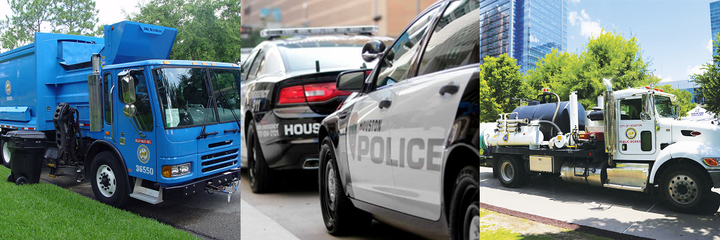How the Houston Fleet Department is Moving Forward
The Houston Fleet Mangement Department manages just under 13,000 vehicles ranging from public safety vehicles to heavy trucks.
In 2017, the City of Houston was hit with 4.5 feet of rain and 130-mph winds. Hurricane Harvey tied with Hurricane Katrina as the costliest tropical cyclone in the U.S., according to the National Oceanic and Atmospheric Administration (NOAA).
The City of Houston lost approximately 300 vehicles in the storm. But in the years since, the city has worked to rebuild its fleet operation with carsharing and alternative fuels programs that will help usher in a new era for the fleet.
Keeping City Operations Moving
Although the city’s motor pool, Fleet Share, was already widely used, these shared vehicles became critical after the storm as user departments worked through Federal Emergency Management Agency (FEMA) reimbursement and city procurement processes to replace department-assigned vehicles, explained Marchelle Cain, chief of staff and deputy assistant director for the Fleet Management Department.
Since 2012, the City of Houston has worked with Zipcar to manage its Fleet Share program. With this technology, city employees enrolled in the program can reserve a vehicle online, locate it, and scan a badge to enter the vehicle.
Motor pools generally rely on high utilization for success, and monitoring vehicle usage allowed the fleet team to maximize that utilization and ensure vehicles were getting multiple reservations in a day. The Fleet Share program includes 160 vehicles stationed at 15 hubs across the city. Using Zipcar’s technology, fleet management can identify popular hubs and move vehicles around to accommodate that demand.
“In response to heavy use, we can add cars, move the hubs, or stand up new hubs in areas where a city department is moving or has hired a new team and needs access to more vehicles,” explained Cain. “The program is designed to be flexible. If one location is not getting used as much as another, we can re‑allocate vehicles and resources to meet the needs of the riders.”
Preparing for Electric Vehicles
Green initiatives are not new to the Houston fleet — the city owns about 600 hybrids and 30 EVs. But it’s something the city has placed a special emphasis on in recent years.
Houston Mayor Sylvester Turner is co-chair of the Climate Mayors, a network of U.S. mayors who aim to demonstrate leadership on climate change and helped develop an EV purchasing cooperative. When first formed, the cooperative included 142 agencies committed to purchasing more than 2,100 EVs by the end of 2020. But this cooperative pricing is available to any government fleet.
The City of Houston plans to purchase EVs through this cooperative soon. During the first round of replacements after Hurricane Harvey, the fleet team learned that purchases made with FEMA reimbursement funds were required to go to bid.
Building for the Future
The fleet team continues to adopt new initiatives. Recently, it began a program to incentivize technicians to get certifications. The city now covers the full cost of a mechanic’s first certification test from the National Institute for Automotive Service Excellence (ASE) and the Emergency Vehicle Technician (EVT) program.
Additionally, the fleet is running a pilot on B-20 — a blend of 20% biodiesel — on its Public Works and Solid Waste trucks that ordinarily run on diesel. If the pilot goes well, the city hopes to adopt the fuel across all heavy-duty diesel vehicles.
The city is also awaiting the arrival of 12 hybrid patrol vehicles as part of a pilot for fleet electrification in severe-duty, high-mileage, and high-idle applications.
Source: https://www.government-fleet.com
FLEET MANAGEMENT AUDIT
Fleet management is the use of a set of vehicles in order to provide services to a third-party, or to perform a task for our organization, in the most efficient and productive manner with a determined level of service and cost.
Fleet management activities are shown in the following graph 1:

Graph 1: fleet management activities
The proposal audit analyses and assesses all fleet management activities shown in the graph 1, and its main goals are:
- Know the overall status of the fleet management activities
- Provide the analysis, the assessment, the advice, the suggestions and the actions to take in order to cut costs and increase the efficiency and efficacy of the fleet management activities
With the information obtained, we’ll elaborate a report that holds the overall status of the fleet management as well as the suggestions, recommendations and the measures to take in order to cut costs and optimize the fleet management activities.
CLICK ON THE FOLLOWING LINK TO DOWNLOAD THE PROPOSED FLEET MANAGEMENT AUDIT:



